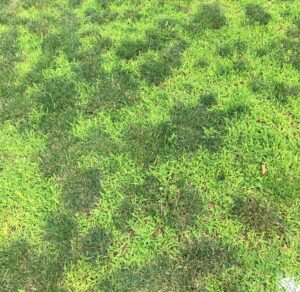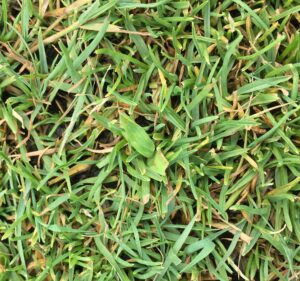Main Content
Over the past 7 to 10 days, warm-season weeds have really turned the corner and are growing rapidly. It’s probably no coincidence that 5-day average soil temperatures finally pushed past 70 degrees about 10 days ago in central NJ. Until last week, most of the crabgrass I observed was growing slowly with a chlorotic appearance. Now it has taken on the more characteristic lime green hue and is growing more rapidly than surrounding cool-season turf. Where previously it was mostly present in thin area of turf, it’s now beginning to make an appearance in dense stands of fine turf such as fairways and greens.

With this post, I’m going to focus mostly on control in in creeping bentgrass where herbicide options are limited. Now is a good time to scout historically problematic areas for small crabgrass and goosegrass plants. If left uncontrolled and allowed to tiller, crabgrass control in creeping bentgrass fairway turf is difficult and with risk of bentgrass injury.

Fenoxaprop (Acclaim Extra) can be applied at 3.5 fl oz/A for control in bentgrass fairways. This rate is 8 to 10X lower than what can be applied to ryegrass, bluegrass and tall fescue to control larger crabgrass plants. At the 3.5 fl oz/A rate, multiple applications on 2 to 3 week intervals may be required to provide control of small leaf-stage crabgrass. If crabgrass is allowed to tiller, even multiple applications of fenoxaprop at rates labeled for use in bentgrass fairways may be a losing battle, so scouting is important. Quinclorac (Drive XLR8, Quinclorac 75DF) is an option to control tillered plants in bentgrass. At rates labeled for use in creeping bentgrass multiple applications may be required. Refer to the label for more information about rates, turfgrass tolerance and adjuvants.
Fenoxaprop will also provide suppression or control of small goosegrass plants. However, once goosegrass begins to tiller, fenoxaprop is less effective at low rates.
Topramezone (Pylex) is an effective herbicide for goosegrass control in cool-season turf. However, in creeping bentgrass fairways, Pylex is labeled for application at up to 0.25 fl oz/A. Tolerance may vary depending on bentgrass cultivar and other management practices. Topramezone causes bleaching of susceptible plant tissue and while limited bleaching is not detrimental to fairway turf from an agronomic perspective, it is very noticeable to even a casual observer. I hate to copy instructions from a bottle of carpet cleaner, but it’s a good idea to make an application to a small area of bentgrass and wait 10 to 14 days to make sure the bleaching you observe is acceptable. My experience with low rates of topramezone for goosegrass control is limited, but multiple applications may be required depending on plant size. Include methylated seed oil or crop oil with Pylex per the product label. Other cool-season grasses such as Kentucky bluegrass, ryegrass, tall fescue and fine fescue are more tolerant than creeping bentgrass and application at higher rates is permitted.
Crabgrass and goosegrass will continue to germinate throughout the summer. If you are observing significant breakthrough in areas already treated with a pre-emergence herbicide consider applying a pre-emergence herbicide with a different mode of action than previously applied. One example is Anderson’s Goosegrass/Crabgrass Control, which contains oxadiazon. Oxadiazon is a PPO inhibiting herbicide, not a mitotic inhibiting herbicide like most other pre-emergents (i.e., bensulide, dithiopyr, pendimethalin, prodiamine). Anderson’s Goosegrass/Crabgrass Control should be applied to dry turf and is labeled for use on bentgrass putting greens. Another example of an herbicide with a different mode of action is Tower (dimethenamid-P). Tower is labeled for use on bentgrass fairways and tees. Read the label for more information on turfgrass tolerance to both of these products.
For information on crabgrass and goosegrass ID and control other turfgrass areas, see this previous post.
The mention of trade names and rates is for educational purposes and does not imply endorsement by the author, Rutgers Center for Turfgrass Science, or the New Jersey Agricultural Experiment Station. Always defer to the product label for instructions on properly applying an herbicide.